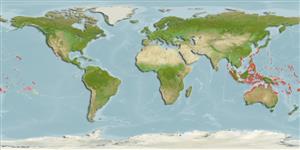>
Blenniiformes (Blennies) >
Blenniidae (Combtooth blennies) > Salariinae
Etymology: Entomacrodus: Greek, ento = inside + Greek, makros = big + Greek, odous = teeth (Ref. 45335); caudofasciatus: Name from Latin 'cauda' for tail and 'fasciatus' meaning with bars, referring to the caudal-fin color pattern of the species (R. Bajol, pers. Comm. 11/14)..
More on author: Regan.
Environment: milieu / climate zone / depth range / distribution range
Ecologie
marien rifbewoner; diepte 0 - 3 m (Ref. 30874). Tropical; 32°N - 31°S
Indo-Pacific: Andamans to Ducie Islands, north to southern Japan, south to Cocos-Keeling, Kermadec, and Rapa Islands; Belau and Marshall Islands in Micronesia.
Grootte / Gewicht / Leeftijd
Maturity: Lm ? range ? - ? cm
Max length : 6.2 cm SL mannelijk / geslacht onbekend; (Ref. 1602)
Dorsale stekels (totaal): 13; Dorsale zachte stralen (totaal): 14-16; Anale stekels 2; Anale zachte stralen: 15 - 17
Facultative air-breathing (Ref. 126274); Adults are found along rocky intertidal shorelines, benches, outer reef flats, and reef margins subject to some degree of wave action. Feeds on filamentous algae (Ref. 89972). Oviparous. Eggs are demersal and adhesive (Ref. 205), and are attached to the substrate via a filamentous, adhesive pad or pedestal (Ref. 94114). Larvae are planktonic, often found in shallow, coastal waters (Ref. 94114).
Levenscyclus en paargedrag
Maturiteit | Voortplanting | Paaien | Eieren | Fecunditeit | Larven
Oviparous, distinct pairing (Ref. 205).
Myers, R.F., 1991. Micronesian reef fishes. Second Ed. Coral Graphics, Barrigada, Guam. 298 p. (Ref. 1602)
Status op de Rode Lijst van het IUCN (Ref. 130435)
Gevaar voor de mens
Harmless
Gebruik door de mens
Meer informatie
ReferentiesAquacultuurAquacultuurprofielKweeklijnenGeneticaElectrophoresesErfelijkheidZiektesVerwerkingNutrientsMassaconversie
Tools
Warning: mysqli::__construct(): (HY000/1040): Too many connections in /var/www/html/includes/speciessummary.lib.php on line 2414
Can't connect to MySQL database fbquizv2. Errorcode: Too many connections
